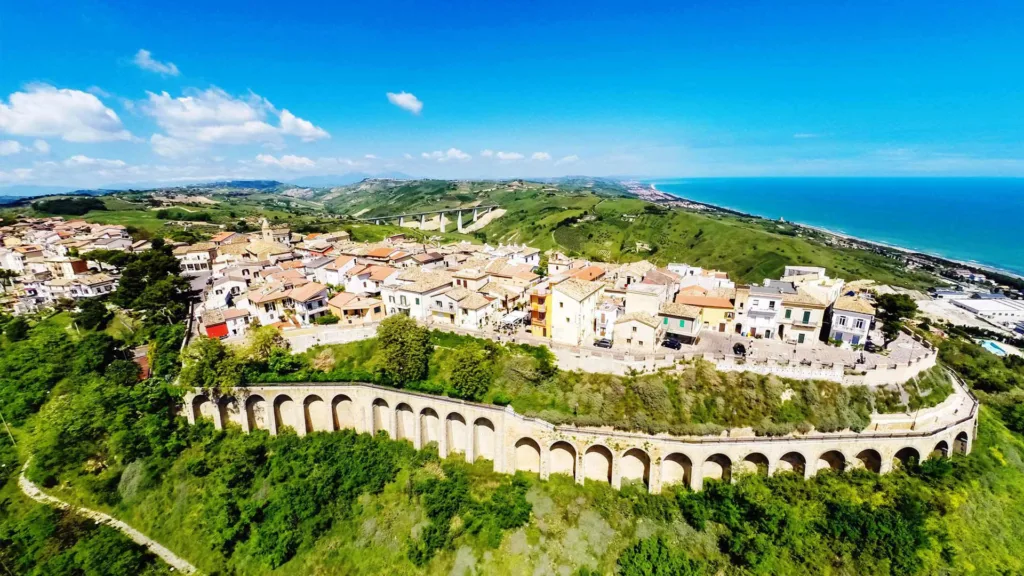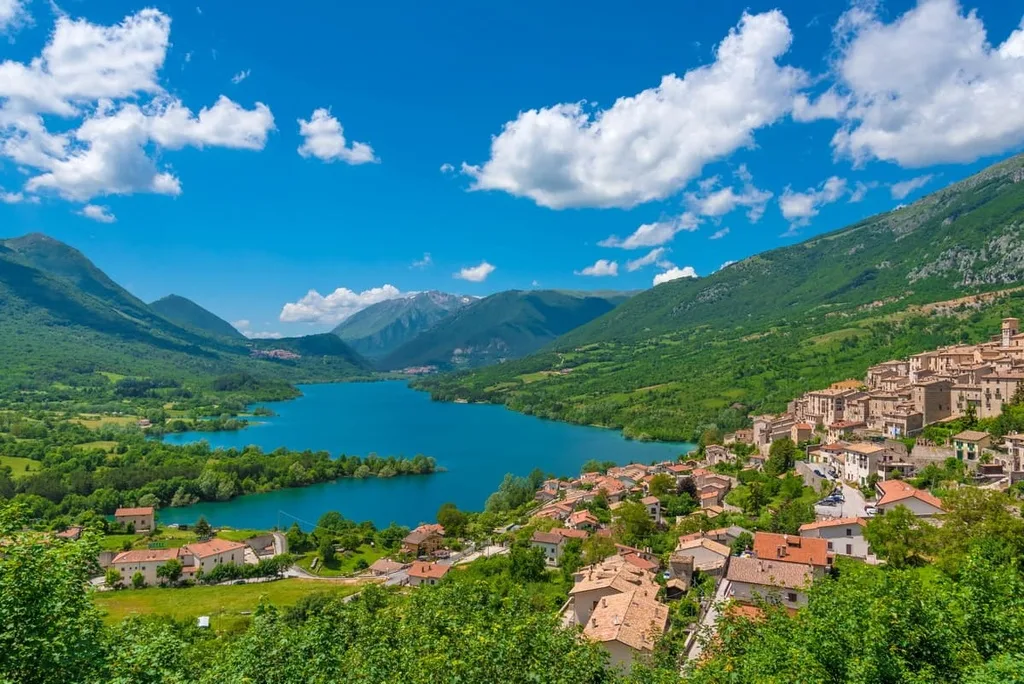L’Aquila, Abruzzo is a city of contrasts, blending medieval streets, Baroque churches, and modern resilience after the 2009 earthquake. Surrounded by the Apennines, it also serves as the gateway to Gran Sasso e Monti della Laga National Park. With its mix of cultural landmarks, natural wonders, and seasonal experiences, L’Aquila rewards slow travel and exploration. Its timeless charm makes it an evergreen destination for culture lovers and outdoor adventurers.

Table of Contents
ToggleTop Things to Do in L’Aquila
Basilica di Santa Maria di Collemaggio
The Basilica di Collemaggio is L’Aquila’s most important religious site. Built in 1288, it is known for its pink-and-white stone façade and Romanesque-Gothic architecture. Inside, the church hosts the annual Perdonanza Celestiniana, inscribed by UNESCO (Intangible Cultural Heritage) in 2019. The basilica reopened in December 2017 after a major restoration, symbolizing the city’s rebirth. Visitors admire its geometric patterns, impressive nave, and peaceful cloisters.
Forte Spagnolo (Spanish Fort)
Built in the 16th century under Spanish rule, the fortress dominates the skyline with its thick walls and angular bastions. Today, it is under restoration and interior access is limited, but the imposing exterior can be admired year-round. The grounds are a pleasant spot for walks at sunset. The Museo Nazionale d’Abruzzo (MUNDA) once operated here but has since relocated.
MUNDA Museum
The Museo Nazionale d’Abruzzo (MUNDA) houses artworks from medieval to modern times. Located in the Ex‑Mattatoio building in Borgo Rivera, near the Fontana delle 99 Cannelle, it features sculptures, paintings, and archaeological finds that trace Abruzzo’s history. Temporary exhibitions keep the museum fresh for returning visitors.
Fontana delle 99 Cannelle
This fountain, built in 1272, has 99 spouts representing the castles that founded L’Aquila. It is one of the city’s most photographed landmarks. Situated in Borgo Rivera, it offers a tranquil setting with medieval houses and leafy paths. The carved stone masks spouting water create a soothing rhythm.
Piazza Duomo and Historic Center
Piazza Duomo is the heart of L’Aquila, lined with cafés, restaurants, and baroque churches. It’s the perfect place for a morning espresso or evening aperitivo. The surrounding alleys of the centro storico reveal artisan shops and restored palazzi that showcase the city’s resilience.
Gran Sasso and Campo Imperatore
Funivia del Gran Sasso (Cable Car)
From Fonte Cerreto, the cable car reaches Campo Imperatore in minutes. Seasonal schedules apply, so check timetables before visiting. At 2,100 meters, the plateau offers sweeping views and is a base for hikes. Corno Grande, the highest peak of the Apennines, towers above. In summer, it serves trekkers and cyclists, while in winter it connects skiers to the slopes.
Campo Imperatore
Known as “Little Tibet,” this vast plateau is famous for its hiking trails, cycling routes, and night skies. In winter it becomes a ski area with trails for all levels. Mussolini was once imprisoned here during WWII before being freed in a daring raid. Today, Campo Imperatore attracts nature lovers with alpine flowers in summer and crisp mountain air year-round.
Hiking and Outdoor Activities
Trails from Campo Imperatore lead into the Gran Sasso mountains. Popular routes include the ascent to Corno Grande and panoramic walks across the plateau. Cyclists ride the winding roads, families picnic in the meadows, and wildlife watchers may spot eagles and chamois.
Day Trips from L’Aquila
Rocca Calascio
Rocca Calascio is one of Italy’s most breathtaking mountaintop castles. At 1,460 meters, the ruins offer panoramic views of valleys and peaks. Featured in films like Ladyhawke and The Name of the Rose, it is best visited at sunset. Access is free from roughly 9:00 to sunset. In peak season, shuttles run from the parking areas and a short uphill path leads to the ruins.
Santo Stefano di Sessanio
This medieval hilltop village is among Italy’s most beautiful borghi. Its stone houses, towers, and alleys create a romantic atmosphere. Accommodations follow the albergo diffuso concept, with rooms spread across restored houses. The village is also famous for its lentils, an Abruzzo specialty.
Grotte di Stiffe
The Grotte di Stiffe are caves shaped by an active river. Guided tours reveal waterfalls, stalactites, and underground chambers. The sound of rushing water makes this a unique cave visit. Tours last about an hour and are family-friendly, making it an easy half-day trip.
Navelli and the Saffron Plateau
South of L’Aquila, Navelli is renowned for its saffron fields. In autumn, purple flowers blanket the plateau, and saffron is harvested by hand. Visitors can tour the fields, learn about cultivation, and taste dishes made with Zafferano dell’Aquila DOP.
Seasonal Experiences
Winter Sports in Abruzzo
Close to L’Aquila are the ski resorts of Campo Felice and Ovindoli. Together with Campo Imperatore, they form the Tre Nevi or “Skipass dei Parchi” consortium, offering dozens of kilometers of slopes. Winter sports enthusiasts enjoy skiing, snowboarding, and snowshoeing. Families find ski schools and beginner-friendly areas.
Spring and Summer Adventures
Spring brings wildflowers to the mountains, making it perfect for hiking. Summer invites cycling, paragliding, and high-altitude picnics. Festivals fill piazzas with music, food, and traditions.
Autumn Colors and Food
Autumn brings glowing landscapes and chestnut harvests. It is also saffron season on the Navelli plateau. Local dishes feature the golden spice in risottos, pastas, and desserts.
Food and Drink in L’Aquila
Zafferano dell’Aquila DOP
Saffron is Abruzzo’s most prized spice. In L’Aquila, it appears in risotto, pasta, and desserts. The Navelli plateau produces saffron with a distinctive aroma, protected under the DOP label. Festivals celebrate the harvest each autumn.
Traditional Dishes
L’Aquila offers hearty mountain cuisine. Arrosticini, skewers of grilled lamb, are a must-try. Pasta alla chitarra, cut with a guitar-like tool, is often served with lamb ragù. Pecorino from local shepherds is another specialty.
Local Wines
Abruzzo is known for its wines. Montepulciano d’Abruzzo pairs with grilled meats, while Trebbiano d’Abruzzo is a crisp white ideal for lighter dishes. Wineries around L’Aquila offer tastings.
Practical Travel Information
How to Get to L’Aquila
L’Aquila is well connected to Rome. Direct buses from Roma Tiburtina (TUA and others) take 1.5–2 hours via the A24. Trains exist but are slower, usually around 3 hours with changes. Driving offers flexibility for day trips.
Getting Around the City
Most attractions lie within the historic center, so walking is best. A large multi‑level car park at the Terminal “Lorenzo Natali” (Collemaggio) connects to the center via a pedestrian tunnel and elevators; a shuttle runs at peak times. ZTL zones restrict car access, so check signage. Accessibility is improved by elevators and shuttle options.
Where to Stay
Centro Storico: Stay near Piazza Duomo for lively cafés and easy sightseeing.
Borgo Rivera: A quieter area near the river and MUNDA museum.
Assergi / Fonte Cerreto: Ideal for hikers and skiers near the cable car.
Santo Stefano di Sessanio: Romantic village stays in unique stone houses.
Top Rated Hotels in L'Aquila
1. 🔍Madi city Hotel – A boutique hotel just off Corso Federico II in the centre. Newly renovated, quiet yet central, with private parking and a rich breakfast. Guests say it’s “very central, yet quiet.”
Rating: 9.6/10 (20 reviews)
2. 🔍La Dimora del Baco Hotel – Located a few minutes’ drive from the centre. Spacious modern rooms, garden, restaurant, and excellent breakfast. Guests highlight the “big room, super comfy bed, very good breakfast.”
Rating: 9.2/10 (195 reviews)
3. 🔍My Suite Hotel – Contemporary hotel near the centre with panoramic views. Free parking, pet-friendly, excellent breakfast, and easy access to buses for Rome. Guests note the “amazing hospitality and excellent breakfast.”
Rating: 9.0/10 (1,062 reviews)
4. 🔍Hotel La Compagnia Del Viaggiatore – Family-run hotel about 6 km from the centre. Offers pools, parking, and a good restaurant. Guests say it’s a “fantastic place to stay with great facilities.”
Rating: 9.0/10 (820 reviews)
5. 🔍Hotel 99 Cannelle – Set in a historic building in Borgo Rivera by the 99 Spouts Fountain. Comfortable rooms, helpful staff, and a good breakfast. Guests mention “fabulous staff and lovely building.”
Rating: 8.7/10 (355 reviews)
Top Rated Apartments in L'Aquila
1. 🔍Civico16 Appartamento – Stylish one-bedroom apartment with balcony in the Old Town. Spotlessly clean and praised for its “unbeatable central location.”
Rating: 9.6/10 (211 reviews)
2. 🔍IN MEDIA URBE – Intero Appartamento – Modern two-bedroom apartment with balcony in the historic centre. Guests describe it as “central, clean, and feels like home.”
Rating: 9.5/10 (201 reviews)
3. 🔍L’Aquila Apartment – Recently renovated two-bedroom apartment near Piazza Santa Margherita, featuring a large terrace. Reviewers highlight the comfy beds, helpful host, and central setting.
Rating: 9.4/10 (144 reviews)
4. 🔍Casa Giulia – Cozy one-bedroom apartment on the ground floor. Guests appreciate the easy check-in, excellent value, free secure parking, and superb location.
Rating: 9.4/10 (154 reviews)
5. 🔍La Piazzetta 2.0 – Well-equipped two-bedroom apartment in the centre. Loved for its great kitchen, very comfortable beds, and welcoming hosts.
Rating: 9.6/10 (60 reviews)
Suggested Itineraries
One Day in L’Aquila
Morning: Basilica di Collemaggio, Fontana delle 99 Cannelle
Afternoon: MUNDA museum, walk around Piazza Duomo
Evening: Dinner in the historic center
Two Days in L’Aquila
Day one as above. On day two, take the cable car to Campo Imperatore for hiking or skiing. Enjoy local dishes at a mountain rifugio.
Three Days in L’Aquila
Add a day trip to Rocca Calascio and Santo Stefano di Sessanio. Stop at Grotte di Stiffe or Navelli for a deeper cultural experience.
FAQs
Is L’Aquila worth visiting?
Yes, with its historic sites, cultural events, and natural beauty, it offers a rich travel experience. Its timeless attractions make it a destination for all seasons.
How do I get from Rome to L’Aquila?
The fastest way is by direct bus from Roma Tiburtina (1.5–2 hours). Driving offers flexibility for day trips.
Is the Gran Sasso cable car open year-round?
It operates seasonally. Always check current schedules before planning.
Can I visit Rocca Calascio at any time?
Yes, it is open daily during daylight hours, though access may be limited in winter. Shuttles run in summer.
What local food should I try in L’Aquila?
Try saffron dishes, arrosticini, pasta alla chitarra, and lentils from Santo Stefano di Sessanio.
Where can I ski near L’Aquila?
Campo Felice, Ovindoli, and Campo Imperatore are nearby resorts with modern facilities.
Conclusion
L’Aquila, Abruzzo combines medieval heritage, vibrant traditions, and mountain landscapes. Whether for culture, cuisine, or adventure, this city offers an unforgettable journey. From the grandeur of Collemaggio to the wild beauty of Gran Sasso, every season brings a new reason to visit. L’Aquila’s cultural vitality and natural beauty ensure it remains an evergreen destination worth discovering again and again.
Disclosure: This page may contain affiliate links. This means that we get a small commission from any purchase you make, at no additional cost to you!

